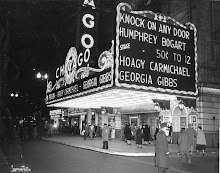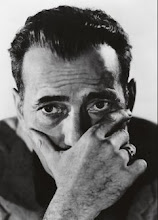When six GIs were photographed raising the
American flag over the Japanese island of Iwo Jima on 23 February 1945 they had
no idea it would change their lives forever.
FLAGS OF OUR FATHERS is the true story of
how that one black and white picture helped win
World War Two. It’s also the
story of how it was misrepresented and the soldiers featured in it manipulated
to serve a greater cause.
One
of them was Navy corpsman John “Doc” Bradley (Ryan Phillippe). Afterwards he
would never talk about his wartime experiences, so following his death his son
sets out on a journey across the USA to interview the last survivors
of that bloody battle, in an attempt to discover the truth of what happened.
The reality he uncovers reveals how a
legend is created, and how that process distorts and rewrites the truth to suit
a different purpose. The flag raising photo was one of many taken that February
day by a journalist accompanying the troops, but it seized the imagination of a
war weary nation. To them it represented victory. The fact that it actually
happened just five days into a thirty five day battle for control of the island
when the outcome was still far from certain, was immaterial.
The US government was quick to recognise
the propaganda value of the picture. After more than three years of fighting
the United States
was almost broke, and there was a real fear that they would be forced to
negotiate a peace treaty with the Japanese because they could no longer afford
to pay for guns and bullets.
The photo became the focal point of a new
campaign to raise desperately needed funds by persuading the American public to
buy more war bonds. The order went out for the soldiers in the picture to be
brought home to front the campaign, touring the country and speaking at rallies
where their presence as real life heroes would encourage people to open their
wallets.
There were just two problems. All the
soldiers in the photo had their back to the camera and no one could remember for
certain who they all were. Some of them were already dead, killed in the fierce
fighting. The other problem was that the photo actually captured a second flag
raising. A different group of soldiers had already planted Old Glory on the top
of the mountain. This was just a replacement, and on neither occasion was it raised
in the heat of battle.
For the US government and military however,
the symbolic value was too important to let the facts get in the way, and the
three somewhat bewildered surviving soldiers were brought home to do their
patriotic duty. Of the three it is Private Ira Hayes, played by Adam Beach, who
has the hardest time dealing with the deceit. The film charts his mental
disintegration as he turns to alcohol, unable to cope with being labelled “a
hero” by the same people who patronisingly call him “chief” and treat him as a
second class citizen because he’s American Indian. Today, we would also recognise
him as suffering from post traumatic stress disorder.
But it’s wrong to assume FLAGS OF OUR
FATHERS is an anti-American film. Director Clint Eastwood’s aim in telling this
story is not to denigrate the myth, mock the patriotism or belittle the
achievements and sacrifices of the men involved. What he does is return the
flag raising event to its proper context, portraying it as an event performed
by a group of men who gave it little thought at the
time because their energy
was focused on capturing the island. They were true heroes not for planting a
flag on top of a mountain, but for the incredible bravery they displayed in
taking on an enemy which was prepared to literally fight to the death. The camera doesn’t flinch in showing us the
full bloody horror and confusion of war, and how thousands of young men died
fighting for each other. They weren’t thinking of the Stars and Stripes or
abstract notions of patriotism and heroism when they charged towards Japanese
machine gun nests. They were trying to save their own life and the lives of their
buddies. The battlefield sequences are nightmarish scenes of graphic carnage, made
disturbingly real by Eastwood’s decision to drain them of colour, giving them
the look of genuine World War 2 newsreel footage.
The camera doesn’t flinch in showing us the
full bloody horror and confusion of war, and how thousands of young men died
fighting for each other. They weren’t thinking of the Stars and Stripes or
abstract notions of patriotism and heroism when they charged towards Japanese
machine gun nests. They were trying to save their own life and the lives of their
buddies. The battlefield sequences are nightmarish scenes of graphic carnage, made
disturbingly real by Eastwood’s decision to drain them of colour, giving them
the look of genuine World War 2 newsreel footage.
The message to take away from this film is
that, despite the official manipulation and dishonesty, the flag raising photo stands
as a symbol of the heroism displayed by thousands of GIs on the battlefield,
rather than a heroic act in itself, and therefore still has value. But it must
also be remembered that these men were real people with families waiting for
them back home, and those that survived were haunted by their experience for
the rest of their lives.
This is not the easiest film to get into. The
first thirty minutes are very disorienting with the story jumping around in
time, from the battle on the beaches at Iwo Jima, to the present day, to the
war bonds tour across the USA.
This lack of a stable storyline creates the same kind of confusion that happens
in war. We are not really sure what is going on because we cannot see the full
picture. It is in exactly this kind of situation that an event can be taken out
of context by people not in full command of the facts and used to promote a
message not anticipated by those involved in the original event.



No comments:
Post a Comment